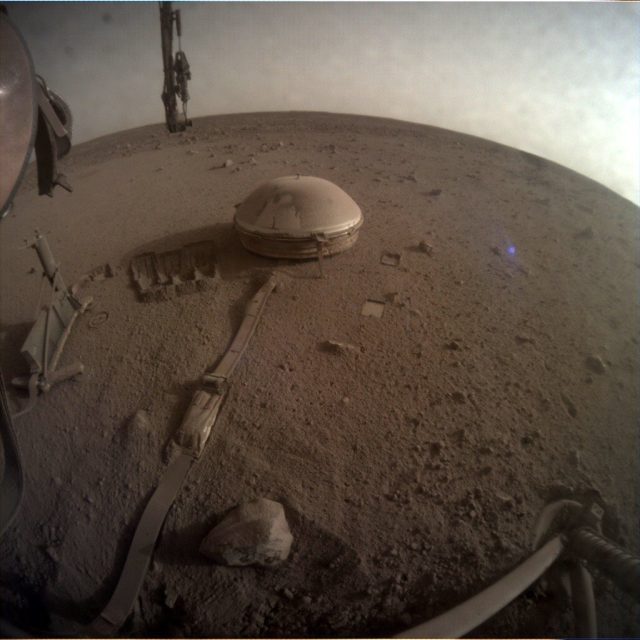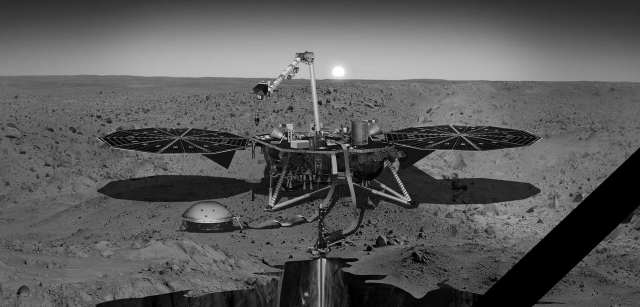Last Sunday, an attempt to communicate with the InSight research landing platform, which has worked on Mars for more than four years, failed. The device, which has considerably exceeded its service life, did not respond and, most likely, will never be able to. Over the past few months, the energy output of its solar panels has been continuously declining.
The US National Aeronautics and Space Administration (NASA) posted a short message on the InSight mission blog about communication problems. It clarifies that the last time it was possible to establish communication with the device was on December 15. Presumably, the landing platform no longer has enough power to transmit data.
Such an outcome was predicted from the very beginning of the mission, but the "silence" of the device, judging by the NASA message, still became a little unexpected. The specific reason for the lack of energy, as noted, is unknown. We add that, most likely, it will not be possible to install it. One can only assume that InSight's solar panels were finally covered with dust and they no longer had time to charge degraded batteries to the required level in one day.
It is somewhat ironic that at the time of its landing on Mars, InSight became the most energetically armed of all the vehicles that visited this planet. The output of its two huge solar panels initially reached 4.6 kilowatt-hours per Martian day (sol). For comparison, equipped with a "nuclear battery" — RTG, the Curiosity rover produced 2.8 kilowatt—hours per day. Such a powerful power supply system was obtained by the InSight probe precisely because of its dependence on sunlight.
The project was developed under strict budgetary and time constraints. To reduce the cost, the architecture of the Phoenix landing platform was chosen (primarsirovalsya in 2008), which was improved and equipped with new generation solar panels. In addition, InSight sat almost at the equator to get as much energy as possible. In addition, at the time of the creation of the device, NASA had problems with the purchase of plutonium-238 for radioisotope generators, which could also affect the choice of power source.

The last photo taken by the device was posted on the mission's Twitter on December 20. The caption reads: "There is very little energy, so this may be the last image I will send. However, don't worry about me—my time here has been both productive and serene. If I can talk to the team further, I will, but very soon I will be disconnected for good. Thank you for being with me"Image source: NASA, InSight team, Twitter
As a result, initially InSight's service life was limited solely by the vicissitudes of the Martian weather. The more dust settled on the panels, the more their efficiency decreased. In 2021, a dust devil (a small tornado) walked right through the device and the output increased slightly. Since May of the same year, mission engineers have tried to pour sand with InSight's robotic arm onto the edge of the solar panel so that it drags the dust lying nearby, but it didn't really help.
The main scientific program of the mission ended two years ago, the expanded nominally continues to this day. However, over the past few months, power outages have become more noticeable. Although the mission team managed to limit the functionality of the device almost to the last. By December 2022, InSight was still operating two of the three main scientific instruments (the SEIS seismometer and the RISE experiment), as well as an additional one (the TWINS weather station). Simply put, everything except the long-suffering submersible probe. A little over a week ago, NASA reported that the production of solar panels for sol was approximately 285 watt-hours, while there was a moderate amount of dust in the atmosphere.
InSight was supposed to work on Mars for two years, eventually served all four. This is the first specialized geological apparatus on the Red Planet. Thanks to his data, it was possible to significantly expand our knowledge about its internal structure. Even despite the failure with one of the key tools — the HP3 mole, which is html" target="_blank" rel="nofollow">failed to dive five meters deep into the planet — the success of the mission is enormous.
There are chances that InSight will get in touch again, but they are minimal and getting smaller every day.

